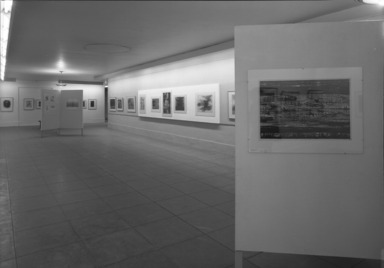

Gabor Peterdi: 25 Years of His Prints, 1934-1959, October 27, 1959 through January 03, 1960 (Image: PHO_E1959i027.jpg Brooklyn Museum photograph, 1959)
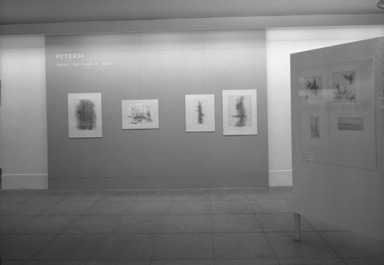
Gabor Peterdi: 25 Years of His Prints, 1934-1959, October 27, 1959 through January 03, 1960 (Image: PHO_E1959i028.jpg Brooklyn Museum photograph, 1959)
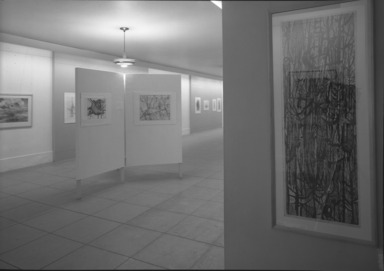
Gabor Peterdi: 25 Years of His Prints, 1934-1959, October 27, 1959 through January 03, 1960 (Image: PHO_E1959i029.jpg Brooklyn Museum photograph, 1959)
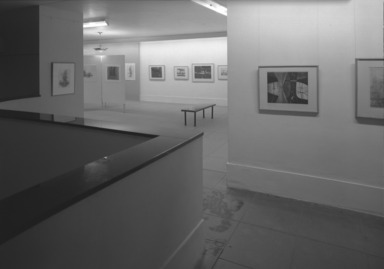
Gabor Peterdi: 25 Years of His Prints, 1934-1959, October 27, 1959 through January 03, 1960 (Image: PHO_E1959i030.jpg Brooklyn Museum photograph, 1959)
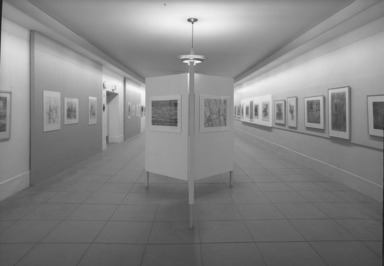
Gabor Peterdi: 25 Years of His Prints, 1934-1959, October 27, 1959 through January 03, 1960 (Image: PHO_E1959i031.jpg Brooklyn Museum photograph, 1959)
Gabor Peterdi: 25 Years of His Prints, 1934-1959
-
October 6, 1959
One hundred and thirty prints of Gabor Peterdi will be on display at the Brooklyn Museum from October 27 through January 3. This retrospective exhibition of his work from 1934 to the present, dramatically illustrates the variety of subjects and techniques of the noted artist.
Earlier this month, Peterdi won the largest cash prize ever given in the history of print making. From more than 600 new works by living American artists, Peterdi's TRIUMPH OF WEED, was selected for the $2,500 prize. The award-winning etching, on view in the Brooklyn exhibition, is one of many highlights of the most comprehensive show of pictures by the artist who stated, "A work of art is a little universe - it must show development, have a beginning and an end, also it must be organized to function."
The last part of that statement might also describe the artist as well as his art. "Organized to function," Peterdi began his formal study at the Hungarian Academy at the age of 14. The following year he was given his first one-man show at the Ernst Museum, and shortly afterwards he won the coveted Prix de Rome for painting. Continuing his studies at the Accademia di belle Arti in Rome, he recalls, "to finance my fantastic consumption of art materials, I was forced into a rather adventurous life...I wrestled in a circus, I sold postcards and I sang in the streets."
That period of the many "fund-raising" occupations ended in 1931 when he went to Paris and met the renowned Stanley William Hayter, the man who revived modern engraving. Hayter's enthusiastic approach to printmaking so impressed Peterdi that he began his apprenticeship. He described those beginnings in his new book on printmaking, "my experience with the graphic arts started with engraving. I fell in love with it and I engraved for several years before I made my first etching. This self-imposed limitation had no other reason than the fascination to explore thoroughly this pure and powerful technique."
His early engravings were as influenced by the forebodings of war as the works of other sensitive artists in the 1930s when Picasso issued his most notable print, MINOTAUROMACHY and the devastating DREAM AND LIE OF FRANCO. Peterdi expressed the atmosphere of destruction in fantastic figures and symbols in his forceful BLACK BULL series.
In 1939 he came to America. It was a permanent move, noted by Miss Una E. Johnson, Curator of Prints and Drawings at the Brooklyn Museum, who said, "He is one of the more brilliant and dynamic of that talented group of young European artists who came to the United States shortly before the second World War."
When he became an American citizen, he joined the Army and served first as a cartographer and later helped to capture and return escaped Hungarian war criminals. His war experiences influenced his work. The disturbing memories are reflected in the haunting CRUCIFIXION and the sensitive STILL LIFE IN GERMANY. Later, in 1947, new themes entered his work, themes of creation and the elemental forces of nature are the subjects of in AWAKENING, ADAM AND EVE and TRIUMPH OF THE BEAST.
The impressive variety of themes and techniques in Peterdi's prints is defined by Miss Johnson, "...no artist can deny the forces of his lifetime. Peterdi's times of war and peace are interpreted in works of art by this powerful and creative craftsman, illustrating his conviction that art is a distillation of experience."
The range of Peterdi's experience is evidenced in his earliest engravings, RHINOCEROS and BATTLE CRY, etched with enormous skill and flashing force. THE FIGHT FOR SURVIVAL, MASSACRE OF THE INNOCENTS and THE BIG WEB are among those titles from the period when he used an electric drill to achieve a movement more insistent and less mechanical than the usual engraving tools. GERMINATION, SPAWNING and HERALDS OF AWAKENING are from the remarkable series of twenty four prints in which Peterdi expresses the complexity of our existence.
From his later works the fanciful patterns of ocean life THE PURPLE CLAW, THE SPONGE FISHER, WINGS OF THE OCEAN are representative of the collection in the exhibition. DECEMBER WIND, THE BIG TREE and RUSTY LEAVES are among the latest prints in which bold engraved lines are superimposed on etched lines of feathery landscapes. Finally, SELF-PORTRAIT, 1959, reveals the mature and deeply discerning artist who sums up the twenty five years of work represented in the exhibition at the Brooklyn Museum, "Today I think I can say without much exaggeration that I have made prints with practically every known major process in graphic arts."
Brooklyn Museum Archives. Records of the Department of Public Information. Press releases, 1953 - 1970. 1959, 039-041
View Original

